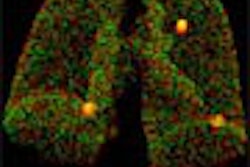ORLANDO, FL - Restaging tumors in the head and neck after surgery can be difficult with either PET or CT alone. However, by fusing the images in a combined PET/CT system, physicians at one institution have demonstrated a dramatic impact on therapeutic strategies.
In a presentation Monday at the Academy of Molecular Imaging conference, researchers from the University of Alabama Medical Center in Birmingham discussed their retrospective analysis of 52 patients with head and neck carcinoma using PET/CT, determining its impact on therapy for the patients.
Dr. Buddhiwardhan Ojha, director of clinical PET at the Alabama facility, outlined the results of the center's investigations with PET/CT in the detection of residual or recurrent head and neck cancers.
The studies were performed on a Discovery LS PET/CT scanner (GE Healthcare, Waukesha, WI), one hour after injecting 555 MBq of F-18 FDG. Each patient had a five-minute scan per bed position, with 6-7 bed positions imaged, according to Ojha.
"The images were visually analyzed and we calculated SUV (standardized uptake values) over the abnormal areas of FDG uptake. We used a cut-off SUV value of 3.0 as our determination of malignancy," Ojha said.
The group found that PET/CT correctly identified 34 cases with residual or recurrent tumor after either surgery or external radiation therapy. Of this group, 22 patients had local recurrence, and four of these patients also had distant metastases. There were eight patients with distant metastases only, and 12 patients who had regional lymph node metastases. Unsuspected metastases were detected in 23% of the cases, Ojha said.
"All the lesions were confirmed with histopathological evidence," he said.
PET/CT correctly downstaged 12 patients, according to results confirmed by biopsy or long-term follow-up, and the modality changed the therapeutic management in 62% of the cases in the study.
The use of PET/CT in restaging head and neck tumors yielded sensitivity of 100%, specificity of 71%, and an overall diagnostic accuracy of 89%. The positive predictive value of the study’s cohort was 87% and the negative predictive value was 100%, Ojha reported.
"The PET/CT images gave us vital information and led to a change in management for a majority of patients in our study," he said. "The ability of FDG-PET to identify abnormal hypermetabolic areas in head and neck cancers treated with radiation and of PET/CT to localize physiological uptake in normal anatomic structures that may be asymmetric due to surgery proved to be vital in management and follow-up of such patients."
By Jonathan S. BatchelorAuntMinnie.com staff writer
March 30, 2004
Related Reading
PET/CT brings added value to pediatric oncology, February 27, 2004
Scintigraphic sentinal node mapping cost-effective for early head and neck cancer, October 31, 2003
PET protocols from head to toe, May 5, 2003
Copyright © 2004 AuntMinnie.com



















